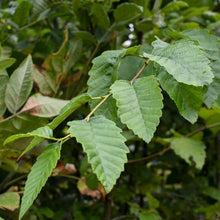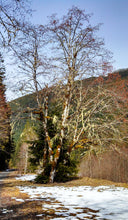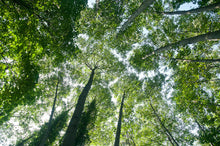Alnus rubra
Red Alder is a fast-growing, broadly-branched, deciduous tree that is favored by songbirds, swallowtail butterflies, and habitat restorationists alike. In Feb or March, cylindrical reddish-orange catkins dangle abundantly from its branches, than give way to seeds adored by finches. It's fall leaves broadcast a dreamy golden color then drop, leaving smooth gray trunks and branches, often covered by large patches of a white lichen which can be used as biomonitors of air quality.
- Plant type/canopy layer: deciduous perennial large tree
- Size at maturity: 40-80' tall, 30-40' wide
- Light requirements: full sun, part-sun/part-shade
- Moisture requirements: wet to dry soil
- Bloom time: Feb - April
- Growth rate/ease: very fast growing, easy to grow
- Wildlife support: Caterpillar host plant and larval food source for moths and butterflies including swallowtails. Utilized by countless species of birds as a source of food, roosting, and nesting, especially in its cavities. Deer and elk eat the leaves, twigs and buds of young trees. Mature stands are a favored habitat for deer. Beavers eat the bark and use the stems for building dams and lodges.
- Native habitat/range: Common along riverbanks, streambanks, bogs, and moist riparian forests and slopes across the Pacific Northwest, from sea level up to 1600 meters, south into CA and north to AK. Portland Plant List - yes.
- Special features & uses: Wildlife favorite. Landscape uses include ecological restoration, hedgerows, windbreaks and erosion control. Humans use the wood extensively for furniture, cabinetry, dishes spoons, platters, paper products and more - second only to Cedars in its use for woodworking by indigenous peoples. Alder wood is also considered the best wood for smoking salmon and generally is an excellent, hot-burning firewood. The bark can be made into a red or orange dye that can be used to make fish nets invisible. The bark can also be used medicinally as it has antibiotic properties and contains salicin, which is used to make aspirin.
Gardening with Red Alder: Red Alder is an ideal tree for larger properties that need ecological restoration, erosion control, hedgerows and/or windbreaks. It is a pioneer, or early succession, species that can easily colonate a landscape after a major disturbance like logging or urbanization. It spreads vigorously, forming thick stands over decades, and tolerates a wide range of light and soil conditions, including low nutrients and flooding. Its roots host nitrogen-fixing bacteria, which can quickly improve the fertility of soils. It is also a relatively brittle tree, so be sure and place this tree in your woodland garden, away from major structures, then sit back and watch as the birds and other wildlife relish in its diverse habitat offerings. Whenever and wherever it's safe to do so, we should allow trees such as Red Alder to drop limbs and branches naturally and leave them where they fall as they are extremely beneficial for wildlife; creating cavity nesting opportunities for birds, brush areas for small mammals and amphibians, and large woody debris recruitment in streams.
Photo Credit 1: Tara Lemezis
Photo Credit 2: "Alnus rubra (Red alder) near Chenuis Falls Trail" by brewbooks is licensed under CC BY-SA 2.0
Photo Credit 3: "Red Alder (Alnus rubra) stand" by Holy Outlaw is licensed under CC BY-ND 2.0






